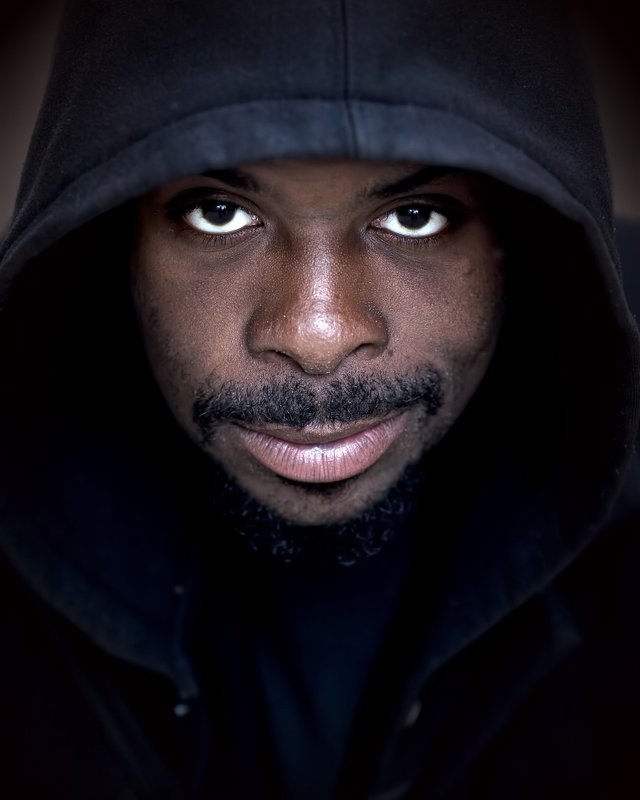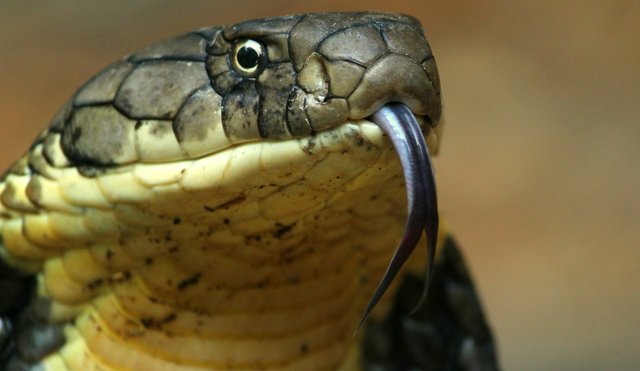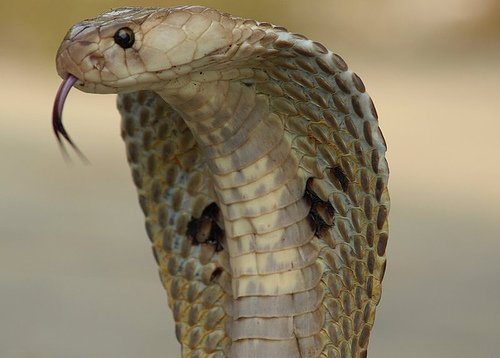Hooded Assassins - The King Cobra

Hooded assassins armed with sophisticated weapons and specialist skills. Their name of terror spans two continents where their name alone evokes widespread panic. Included in their ranks are the world greatest venomous snakes called the cobra mafia! A creature sometimes revered but mostly feared. Born fully independent, instinct begin to drive them and a powerful array of finely tuned senses beginning to power up their mission to survive and to survive they have to kill. They are natural-born killers equipped with an inherited arsenal of deadly weapons and characteristic Cobra bad attitude.

A king Cobra.
Image Source: Wikimedia Commons.
Their presence stirs fear as their family name and reputation precedes them for good reasons. Young Cobras maybe very vulnerable and one out of every 10 is most likely to survive and soon, they discover what they are capable of, for they belong to a veteran gang of predators who rule the reptilian streets of Africa and Asia. The Cobra mafia is a group of “ruthless hitmen” each equipped with a set of skills to run their operations. Is this a family of cold blooded killers or have they just earned a bad reputation?
The King Cobra.
Like most other groups of snakes species, Cobras are armed with hollow fanes designed like hypodermic needles used to inject deadly venom into their victims but it’s the King Cobra’s trademark move and iconic shape that distinguishes them from most other serpents. Raising a third of their body length off the ground they use specially adapted muscles to expand modified ribs and stretching their necks skin they could form hoods striking the defence pose that have terrified their enemies for centuries.
Africa’s hot jungles and Asia are home to this high-ranking mob members of the forest Cobras. One of the biggest, meanest badasses in the reptile kingdom. This specie’s territory stretches throughout the African rain forest and have their cousins in Asia. The King Cobra can grow to almost 17 feet in length and are referred to as the world longest venomous snake. These species titled as “king” are mostly found in India.
A King Standing tall.
Image Source: Wikimedia Commons.
With their elongated muscles and tendons stabilize their ribs and lower body allowing them to extend upward. When they pose this classic “Cobra style move”, they can look a grown man of six feet in the eye and they pack a mighty punch too. They have venom glands that stretches just behind they eyes which enable they inject up to 600 milligram of neurotoxic venom in a single bite and only 20 milligram of their venom is enough to kill a grown man so you can imagine how much of toxic a person would receive if bitten and why it is really hard to save a victim. If we do the maths, It can be said that with one bite of the “king” can inject enough venom to kill 20 persons in few hours let’s say 3 hours.
Although snakes grow all their lives but this snake’s skin doesn’t grow with them, they would have to shed their skin in every few months. If a female shed her skin, it leaves a pheromone trail as she steers a path ahead of the male. The old female skin that have been dumped like an old jacket that serves a beacon to the male’s eye telling him a female is ready to mate and he follows the scent.

King cobras displaying his forked tongue with hood extended.
Image Source: Wikimedia Commons.
.-
King Cobras are known for their aggressive nature and can eat anything that comes their way even while courting a King Cobra can take on his mate and turn his wife to dinner. They typically strikes their classic pose when they feel intimidated because by looking bigger they can frighten away a potential threat.
Most King Cobras have a very secret weapon, their tail’s very last scale is shaped into a hard pin sharp spike which is ripped out like a switchblade when things kick off and just a little jab could trick another snake into believing it’s been beaten.
Snakes have no external ears and no ear drums like we humans do instead the feel vibrations caused by movement it the air and along the ground and these vibrations are been transmitted through the body to the tissue surrounding the jaw bone into the auditory system and then the system relays the vibration signal to the brain.
Diet
The scientific name of the king cobra is Ophiophagus hannah, from the Greek ophio “snake” and phagus “to eat”. That tells it all this guys diet is other long guys. The king cobra feed mostly on other snakes such as kraits, true cobras and small pythons, as well as other king cobras, venomous and non-venomous, brother or distance cousin, you are food to the king! When food is scarce frogs, toads and even fish form a large part of the King’s diet. Did I hear you say fish? Do snakes swim??
Yes the king is not just a great climber or land slither but also excellent swimmers, undulating and thrusting forward, they inflates their lungs keeping their body afloat as they navigates the pools and streams in search of food.
See video of a King swimming below.
Source: National geographic creative
When hunting King cobra don’t only rely on smell or taste, binocular vision enables them to pick up visual cues as subtle as a toads breathing so you now know how easy it is for a Cobra to locate you when next you go camping.
Other species of cobras according to their rank in venom.
| S/N | Species | Common name | Geographic rank in venom |
|---|---|---|---|
| 1 | N. anchietae | Anchieta's cobra (Angolan Cobra) | Angola, Botswana, Namibia, Zambia, eastern Zimbabwe |
| 2 | N. annulata | Banded water cobra | Cameroon, Central African Republic, Democratic Republic of Congo, Republic of Congo, Equatorial Guinea, Gabon, Rwanda, and the province of Cabinda in Angola |
| 3 | N. annulifera | Snouted cobra | Botswana, Malawi, Mozambique, South Africa, Swaziland, Zambia, Zimbabwe |
| 4 | †N. antiqua | Moroccan cobra | Miocene-aged strata of Morocco |
| 5 | N. arabica | Arabian cobra | Oman, Saudi Arabia, Yemen |
| 6 | N. ashei | Ashe's spitting cobra (giant spitting cobra) | Southern Ethiopia, Kenya, Somalia, eastern Uganda |
| 7 | N. atra | Chinese cobra | Southern China, northern Laos, Taiwan, northern Vietnam |
| 8 | N. christyi | Congo water cobra | Democratic Republic of Congo, Republic of Congo, and in the province of Cabinda in Angola |
| 9 | N. haje | Egyptian cobra | Tanzania, Kenya, Somalia, Ethiopia, Uganda, South Sudan, Sudan, Cameroon, Nigeria, Niger, Burkina Faso, Mali, Senegal, Mauritania, Morocco, Algeria, Tunisia, Libya, and Egypt |
| 10 | †N. iberica | Spanish cobra | Miocene-aged strata of Spain |
| 11 | N. kaouthia | Monocled cobra | Bangladesh, Bhutan, Burma, Cambodia, southern China, eastern India, Laos, northwestern Malaysia, Nepal, Thailand, southeastern Tibet, Vietnam |
| 12 | N. katiensis | Mali cobra (Katian spitting cobra) | Benin, Burkina Faso, Cameroon, Ghana, Guinea, Ivory Coast, Mali, Gambia, Mauritania, Niger, Nigeria, Senegal, Togo |
| 13 | N. mandalayensis | Mandalay spitting cobra (Burmese spitting cobra) | Burma |
| 14 | N. melanoleuca | Forest cobra | Angola, Benin, Burkina Faso, Burundi, Cameroon, Central African Republic, Chad, Democratic Republic of the Congo (Zaire), Congo, Ethiopia, Gabon, Ghana, Gambia, Guinea, Guinea Bissau, Ivory Coast, Kenya, Liberia, Malawi, Mali, Mozambique, Niger, Nigeria, Rwanda, Sao Tom'e, Senegal, Sierra Leone, Somalia, South Africa, Sudan, Tanzania, Togo, Uganda, Zambia, Zimbabwe |
| 15 | N. mossambica | Mozambique spitting cobra | Extreme southeastern Angola, Botswana, Malawi, Mozambique, Somalia, northeastern Namibia, South Africa, Swaziland, Tanzania (including Pemba Island), Zambia, Zimbabwe |
| 16 | N. multifasciata | Burrowing cobra | Cameroon, Congo, Democratic Republic of the Congo (Zaire), Gabon |
| 17 | N. naja | Indian cobra (spectacled cobra) | Bangladesh, Bhutan, India, Nepal, Pakistan, Sri Lanka |
| 18 | N. nigricincta | Zebra spitting cobra | Angola, Namibia, South Africa |
| 19 | N. nigricollis | Black-necked spitting cobra | Angola, Benin, Burkina Faso, Burundi, Cameroon, Central African Republic, Chad, Democratic Republic of the Congo (except in the center), Congo, Ethiopia, Gabon, Gambia, Ghana, Guinea Bissau, Guinea, Ivory Coast, Kenya, Liberia, Mali, Mauritania, Namibia, Niger, Nigeria, Rwanda, Senegal, Sierra Leone, Sudan, Tanzania, Somalia, Togo, Uganda, Zambia |
| 20 | N. nivea | Cape cobra (yellow cobra) | Botswana, Lesotho, Namibia, South Africa |
| 21 | N. nubiae | Nubian spitting cobra | Chad, Egypt, Eritrea, Niger, Sudan |
| 22 | N. oxiana | Caspian cobra | Afghanistan, northwest India, Iran, Kyrgyzstan, Pakistan, Tajikistan, Turkmenistan, Uzbekistan |
| 23 | N. pallida | Red spitting cobra | Djibouti, Ethiopia, Kenya, Somalia, Tanzania |
| 24 | N. philippinensis | Philippine cobra | Philippines (Luzon, Mindoro) |
| 25 | †N. romani | †European cobra | Miocene-aged strata of France, Germany, Austria, Romania, and Ukraine |
| 26 | N. sagittifera | Andaman cobra | India (Andaman Islands) |
| 27 | N. samarensis | Samar cobra | Philippines (Mindanao, Bohol, Leyte, Samar, Camiguin) |
| 28 | N. senegalensis | Senegalese cobra | Benin, Burkina Faso, Ghana, Guinea, Mali, Niger, Nigeria, Senegal |
| 29 | N. siamensis | Indochinese spitting cobra | Cambodia, Laos, Thailand, Vietnam |
| 30 | N. sputatrix | Javan spitting cobra | Indonesia (Java, Lesser Sunda Islands, East Timor) |
| 31 | N. sumatrana | Equatorial spitting cobra | Brunei, Indonesia (Sumatra, Borneo, Bangka, Belitung), Malaysia, Philippines (Palawan), southern Thailand, Singapore |
Source:World atlas
How Many Types Of Cobras Are There? Which Species Are Most Venomous?
At this note i will like to draw a line to this post hoping we remember all we've learnt today in anticipation of my next post on snakes (Here’s Venom in Your Eye - Spitting Cobras).
References
King cobra
Naja
12 Facts about King Cobras…
How Many Types Of Cobras Are There? Which Species Are Most Venomous?

Do you write STEM (Science, Technology, Engineering, and Mathematics) related posts? Then you should consider joining the #steemSTEM community on discord here. If you happen to be from Nigeria, you should also consider including the #stemng tag in your post. You can visit @stemng for more information.

I like to think i know a lot about snakes, i watch lots of snake shows and i read a lot about them too but i never knew this
Thanks for adding to my snake knowledge arsenal.
It's nice to know you found this useful and learnt a thing from it.
I was also marveled when I heard that from a TV show and had to do a little dig-deep on it.
Hello @nwambe, please join the discord server for #steemstem here: https://discord.gg/7HxZbCH and for the Nigeria STEM contributors, #stemng, discord here: https://discord.gg/sareQ5N. You can then make friends and get a mentor to guide you in your posts. This post was found to have elements of plagiarism from Wikipedia. Thank you.
Wow... I believe all of this was hand write aside the list of cobras gotten from World atlas which I indicated.
I wish I could know how to check plagiarism myself maybe that will go a long way helping me.
Not withstanding I do appreciate you.
Thanks for the feed back. I hope to understand how things work here and get better at the act of writing.
And for discord, I will be with you soon. Cheers
Congratulations @nwambe! You have completed the following achievement on Steemit and have been rewarded with new badge(s) :
Click on the badge to view your Board of Honor.
If you no longer want to receive notifications, reply to this comment with the word
STOPTo support your work, I also upvoted your post!